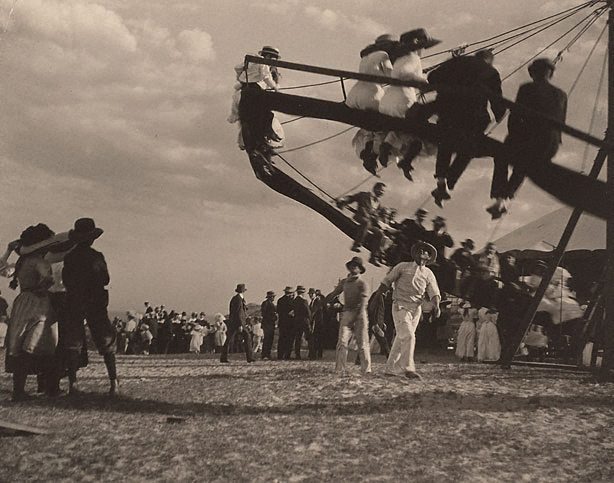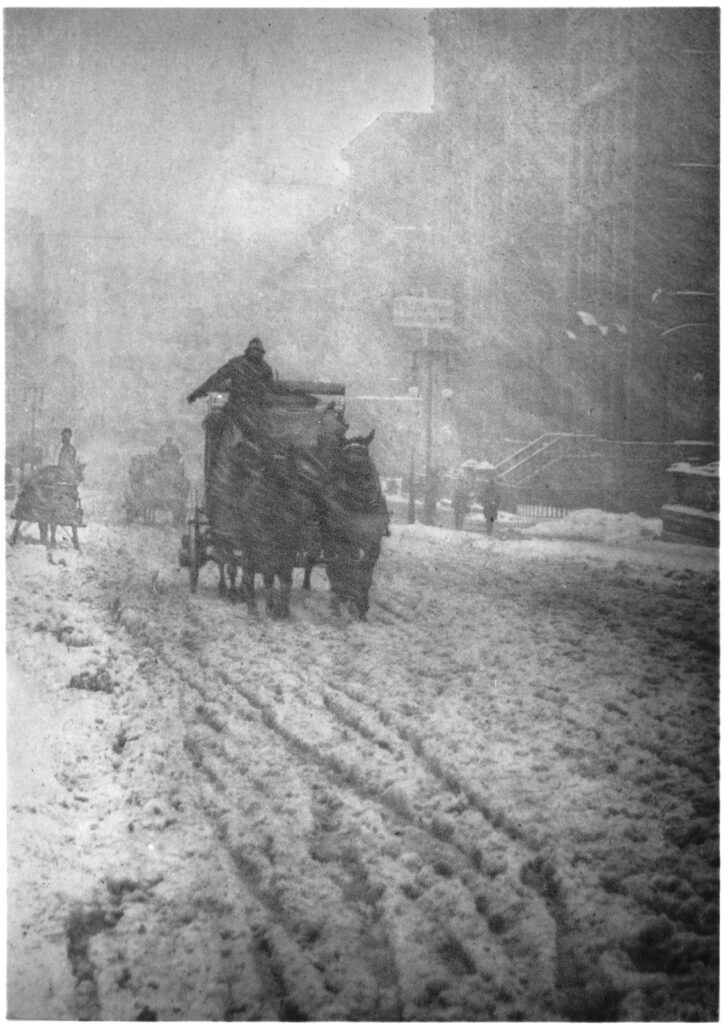
Artist: Harold Cazneaux
Title: Razzle Dazzle
New Zealand, Australia
30 March 1878 – 19 June 1953
Date: 1910
Materials: gelatine silver photograph
Dimensions: 225 x 285mm image/sheet; 311 x 357mm card
With “Razzle Dazzle,” Harold Cazneaux catapulted to international acclaim, solidifying his position at the forefront of pictorialist practice, the era’s most innovative and artistic photographic movement.
“Razzle Dazzle,” taken in 1910, is one of Cazneaux’s most celebrated works.
The photograph captures a dynamic scene at an amusement ride, likely a fairground attraction. The ride is partially visible, with the wheel only captured in part amidst its rotation, creating a sense of movement and excitement. The blurred momentum of the ride’s patrons contrasts with the clear, still silhouettes of onlookers, adding to the dynamic feel of the scene.
This photograph was a significant milestone in Cazneaux’s career. It was exhibited at the London Salon of Photography in 1911 and featured on the cover of The Photographic Monthly in October of the same year. The critical acclaim it received helped establish Cazneaux’s international reputation and positioned him as a leading figure in the Pictorialist movement.
The Pictoralist Movement
So, what was the Pictoralist Movement?
In 1910, the general impression of photography as fine art was heavily influenced by the Pictorialist movement, which sought to establish photography as a legitimate artistic medium on par with painting and sculpture.
Since its invention, photography had been seen as both a scientific and artistic medium. The debate over its true function—whether it should be valued for its ability to document reality or for its potential to create art—was ongoing throughout the 19th and early 20th centuries
At its core, Pictorialism was a global artistic movement that sought to elevate photography beyond mere documentation, instead emphasizing its potential for creative expression and personal interpretation. By doing so, Pictorialists aimed to establish photography as a legitimate art form, capable of conveying emotions, ideas, and experiences.
While many artists and critics embraced the artistic potential of photography, others were skeptical. Some viewed photography as a mere mechanical process that could not achieve the same level of artistic expression as painting. However, the efforts of Pictorialists and their supporters gradually shifted public perception, leading to a greater acceptance of photography as a fine art.
And Harold Cazneaux was seen as an artist who pushed the movement forward.

Harold Cazneaux’s vision

“Razzle Dazzle” does not look groundbreaking to the modern eye, but Cazneaux innovated photography with his technical and stylistic approaches, pushing the boundaries of the medium.
Art historian Isobel Crombie highlighted the photograph’s uniqueness due to its dynamic composition and unusual subject matter. The partial capture of the ride amidst its rotation creates a sense of movement and energy that was innovative for its time
At the same time, Cazneaux’s use of the gelatin silver process and, in some versions, the bromoil process, aligns with the pictorialist movement’s emphasis on creating painterly effects and artistic control over the image.
Cazneaux’s experience in commercial studio work significantly influenced his artistic development. He worked at Freeman & Co. Ltd’s studio in Sydney, where he became manager and chief operator. However, the highly formulaic nature of studio photography left him frustrated and yearning for more creative freedom
“Razzle Dazzle” can be seen as a departure from the rigid constraints of studio photography. It allowed Cazneaux to express his artistic vision more freely, blending his technical skills with a more expressive and dynamic approach. This photograph, along with others from his pictorialist period, helped bridge the gap between commercial and art photography, showcasing his ability to apply studio techniques to create fine art.
Cazneaux’s early studio work involved controlled artificial lighting, but he developed a preference for natural light. He became known for his mastery of light, particularly the unique qualities of Australian sunlight, which became a defining characteristic of his work.
Moving away from the confines of the studio, Cazneaux embraced outdoor photography, capturing landscapes, street scenes, and everyday life. This shift allowed him to explore a broader range of subjects and settings, contributing to the richness and diversity of his portfolio.
The skills he honed in the studio allowed him to manipulate photographic processes to achieve his artistic vision, as seen in his innovative works like “Razzle Dazzle.”
“Razzle Dazzle” by Harold Cazneaux is a masterful example of early 20th-century pictorialist photography. The photograph captures the dynamic energy of an amusement ride through innovative composition and technical prowess, embodying the principles of the pictorialist movement. It played a crucial role in establishing Cazneaux’s international reputation and bridging the gap between commercial and art photography. Through “Razzle Dazzle,” Cazneaux demonstrated his ability to transform photography into a medium for artistic expression, leaving a lasting legacy in the world of fine art photography.

